Online CALPUFF Training Course – Sep 16-17, 2025 – Filling Quickly! |
 |
Spots are quickly filling for our comprehensive 2-day online CALPUFF training course taking place on September 16 and 17, 2025 from 8:30am to 5:00pm (Central Time – Chicago).
Led by our expert instructors, this course offers in-depth instruction and hands-on exercises designed to help you effectively apply the CALPUFF modeling system in real-world scenarios.
Registration is open – secure your spot today!
|
|
Online AERMOD Training Course – Oct 7-8, 2025 - 1 Spot Left! |
 |
Don't miss out on our next available 2-day online AERMOD course taking place on October 7 and 8, 2025 from 8:30am to 5:00pm (Central Time – Chicago, USA).
Register now!
Note: Due to the immense popularity of our online courses and small class sizes, we recommend registering and making payment as soon as possible to reserve your spot.
|
|
Fall 2025 Online Air Dispersion Modeling Courses |
 |
We’re pleased to announce the following upcoming Online AERMOD Air Dispersion Modeling Courses. Experience world-class training led by our senior air quality experts—all from the comfort of your home or office.
Online registration is available now! Our online courses sell out quickly! We recommend registering and making payment as soon as possible.
Don’t miss out - register today!
|
|
Lakes Environmental Closed for Labour Day Holiday |
Lakes Environmental's offices will be closed on Monday, September 1, 2025, to observe the Labour Day holiday. If you have any needs during that time, please e-mail us at support@webLakes.com. and we will contact you on Tuesday, September 2, 2025, when our offices reopen.
|
|
UPCOMING TRAINING COURSES |
|

|
MODELING TIP |
Combining CALPUFF Model Output with CALSUM |
|
The CALPUFF air dispersion modeling system is extremely powerful and contains many refined features for users to conduct air modeling. A consequence of the model’s refined nature means some calculations can take a very long time to complete, however. Some situations may call for a modeler to conduct multiple model runs thus compounding the runtimes.
To more quickly assess cumulative impacts from multiple independent runs, the CALSUM utility can be used to create a set of combined output data. CALSUM can support the following output data types:
- CONC.DAT (concentration)
- DFLX.DAT (dry deposition fluxes)
- WFLX.DAT (wet deposition fluxes)
CALPUFF View includes the CALSUM Wizard which steps users through the process of running CALSUM. It is important to note that CALSUM can only be used if:
- The output files are of the same type (containing either concentrations, wet deposition fluxes, or dry deposition fluxes)
- The time periods contained in the files are identical
- The species are the same and listed in the same order within the CALPUFF setup
- The receptors (e.g., sampling, discrete, etc.) are the same, in terms of number, location, and order
Once that information has been verified, follow these steps to run the CALSUM Wizard:
- Begin by exporting the sources from each project whose output will be combined. Use the Export | Sources menu option to save the sources to an Excel spreadsheet.
- Create a new project to store the combined results. Since the parameters from each run must be the identical, select the Save Project As option to create a copy of the currently opened project.
- Select the Import | Sources menu option and import the Excel spreadsheets you exported in Step 1. Your new project will now contain all of the sources whose output will be combined in CALSUM.
- Select Tools | CALSUM Wizard. On the first step, provide an optional title for the run. The input, list, and output files will be automatically created, but you can change the names of any files as desired. Click Next > when ready.
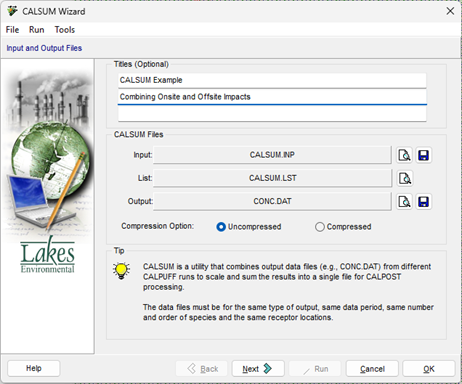
- Verify the Species list. Recall that the species must be the same and in the same order for all projects to be combined. You can import a Species List using the Import button (
 ). Click Next > to proceed. ). Click Next > to proceed.
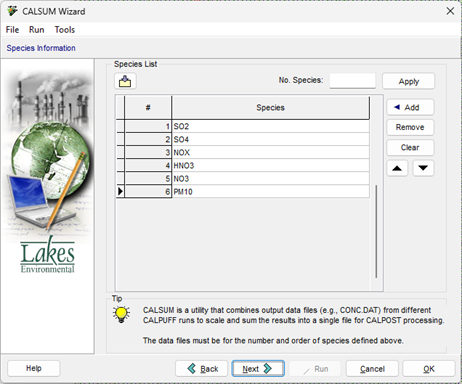
- Now specify in the Data Files and Scaling Options which output files will be combined. Select the Add File button to identify each unique output file.
The concentrations or deposition fluxes in each file may be scaled by using a linear operator of the form (A*x+B) where:
x represents either the concentration or deposition flux
A is the multiplicative constant (A-scale)
B is the additive constant
For example, you can use the B-Scale to add a constant background concentration to the model results. Enable the “Scaling Factor” checkbox for any specified output file to add scaling factors.
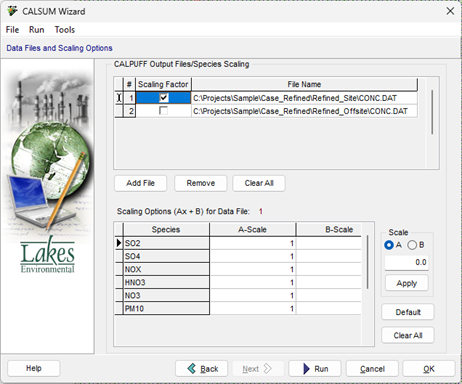
- After specifying all the CALSUM parameters, press the
 button to execute CALSUM. Click OK to close the CALSUM Wizard when the run is complete. button to execute CALSUM. Click OK to close the CALSUM Wizard when the run is complete.
- Re-run CALSUM as necessary to combine other output files (e.g., DFLX.DAT, WFLX.DAT).
- Once your output is combined, execute CALPOST for the newly combined files using CALPUFF View’s CALPOST Wizard.
- Verify your CALPOST model options. When the options are set, select Run | CALPOST Model to process the combined concentrations or deposition fluxes. The images below show Concentration results for a single source facility compared to cumulative concentration results prepared using CALSUM.
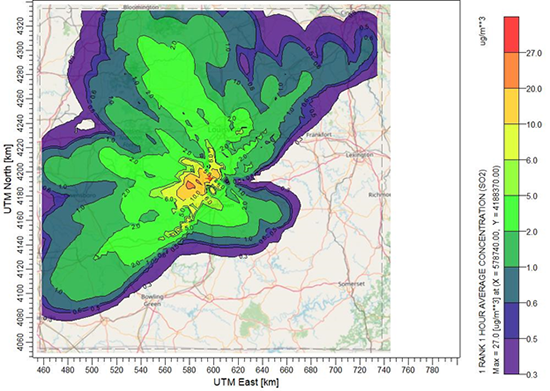
Sample 1-Hour SO2 Concentration Results from Single Source Facility
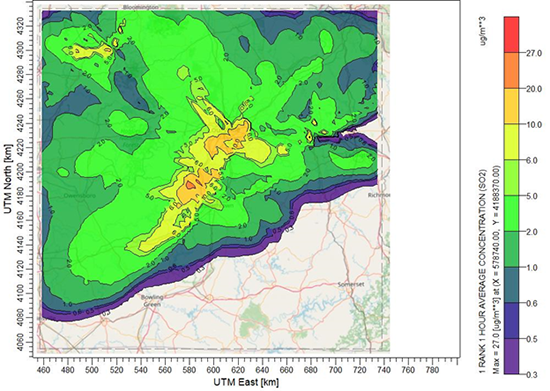
Sample 1-Hour SO2 Concentration Results from Cumulative Sources Prepared Using CALSUM
|
|

|
ENVIRONMENTAL NEWS ARTICLES |
In a Warming Atlantic, Hurricanes Increasingly Arrive in Groups |
August 15, 2025 - As ocean waters heat up, the Atlantic is increasingly seeing not just one, but two or more hurricanes spin up at the same time. That is the finding of a new study, which warns that warming is raising the risk that coastal cities may be battered by back-to-back storms.
Read more → |
|
NASA Supercomputers Take on Life Near Greenland’s Most Active Glacier |
August 8, 2025 - As Greenland’s ice retreats, it’s fueling tiny ocean organisms. To test why, scientists turned to a computer model out of JPL and MIT that’s been called a laboratory in itself.
Read more → |
|
|
|
LAKES SOFTWARE GROUP OF COMPANIES
|
 |
1-170 Columbia St. W.
Waterloo, ON N2L 3L3
View Online
This newsletter contains information gleaned from various sources on the web, with complete links
to the sources cited. Organizations cited are in no way affiliated with Lakes Environmental Software.
For more information, please visit our web site at: www.webLakes.com.
All comments and suggestions are welcome. You can e-mail us at: support@webLakes.com.
Privacy Policy |
|
| | | | |
